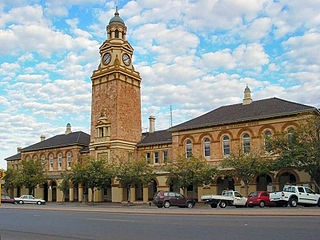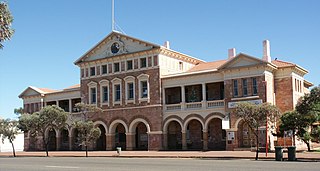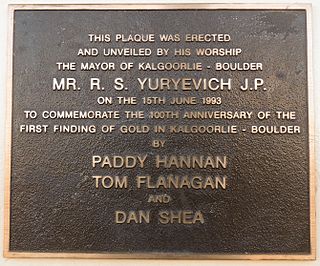
Kalgoorlie is a city in the Goldfields–Esperance region of Western Australia, located 595 km (370 mi) east-northeast of Perth at the end of the Great Eastern Highway. It is sometimes referred to as Kalgoorlie–Boulder, as the surrounding urban area includes the historic townsite of Boulder and the local government area is the City of Kalgoorlie–Boulder.

A gold rush or gold fever is a discovery of gold—sometimes accompanied by other precious metals and rare-earth minerals—that brings an onrush of miners seeking their fortune. Major gold rushes took place in the 19th century in Australia, Greece, New Zealand, Brazil, Chile, South Africa, the United States, and Canada while smaller gold rushes took place elsewhere.

Patrick Hannan was a gold prospector whose lucrative discovery on 14 June 1893 set off a major gold rush in the area now known as Kalgoorlie-Boulder in Western Australia.

Southern Cross is a town in Western Australia, 371 kilometres east of state capital Perth on the Great Eastern Highway. It was founded in 1888 after gold prospectors Richard Greaves and Ted Paine during their October 1887 expedition successfully found gold, and gazetted in 1890. It is the major town and administrative centre of the Shire of Yilgarn. At the 2016 census, Southern Cross had a population of 680.

The Hon. David Wynford Carnegie was an explorer and gold prospector in Western Australia. In 1896 he led an expedition from Coolgardie through the Gibson and Great Sandy Deserts to Halls Creek, and then back again.

Cue is a small town in the Mid West region of Western Australia, located 620 km north-east of Perth. At the 2016 census, Cue had a population of 178. Cue is administered through the Cue Shire Council, which has its chambers in the historic Gentlemans Club building. The current president is Ross Pigdon. The Cue Parliament is held twice yearly in May and November.

Harry Francis Anstey was a metallurgist and gold prospector who led the prospecting expedition that discovered gold in the Yilgarn, leading to the gold rush that established Western Australia's Eastern Goldfields.

Coolgardie is a small town in Western Australia, 558 kilometres (347 mi) east of the state capital, Perth. It has a population of approximately 850 people.
Koolyanobbing is located 54 km (34 mi) north-northeast of the town of Southern Cross, Western Australia. Iron ore has been mined here since 1948 by a series of companies, with a break between 1983 and 1993. The ore is currently railed to the port at Esperance for export. The current owner and operator of the lease is Mineral Resources Limited.

Menzies is a town in the Goldfields-Esperance region of Western Australia, 728 kilometres (452 mi) east-northeast of the state capital, Perth, and 133 kilometres (83 mi) north-northwest of the city of Kalgoorlie. At the 2016 census, Menzies had a population of 108. Aboriginal people have lived in this area since time immemorial, and the local group are the Kaburn Bardu.

Gold mining in Western Australia is the third largest commodity sector in Western Australia (WA), behind iron ore and LNG, with a value of A$17 billion in 2021–22. The 6.9 million troy ounces sold during this time period was the highest amount in 20 years and accounted for almost 70 percent of all gold sold in Australia.

Brigadier General Evan Alexander Wisdom, was an Australian politician, businessman and a senior officer of the Australian Army in the First World War. He was the Mayor of the Municipality of Cottesloe from 1908 to 1911, served as the Western Australian Legislative Assembly Liberal member for Claremont for two terms between 1911 and 1917 and was the Administrator of the Territory of New Guinea from 1921 to 1933. He died in Melbourne aged 76, and was cremated.

During the Australian gold rushes, starting in 1851, significant numbers of workers moved from elsewhere in Australia and overseas to where gold had been discovered. Gold had been found several times before, but the colonial government of New South Wales had suppressed the news out of the fear that it would reduce the workforce and destabilise the economy.
Feysville is an abandoned town in the Goldfields-Esperance region of Western Australia. It is situated between Kalgoorlie and Kambalda just off the Goldfields Highway.
Yundamindera, also once known as The Granites, is an abandoned town located between Leonora and Laverton in the Shire of Leonora in the Goldfields–Esperance region of Western Australia. The town is surrounded by pastoral stations, mostly raising sheep. Some of the leases include Yundamindera Station, Mount Remarkable Station and Mount Celia Station.
Yerilla is an abandoned town located in the Goldfields-Esperance region in Western Australia. It is found between Kalgoorlie and Laverton.

Thomas Flanagan was a gold prospector who in 1893, together with fellow Irishmen Paddy Hannan and Dan Shea, found the first gold in what became the richest goldfield in Australia, in Kalgoorlie, Western Australia.
The Western Australian Goldfields is a term for areas in Western Australia that have had significant areas of gold mining occur.

William Gordon Brookman was an Australian mining entrepreneur and politician. He made a fortune in the Western Australian gold rush of the 1890s, and later served as Mayor of Perth from 1900 to 1901 and as a member of the Legislative Council of Western Australia from 1900 to 1903.
Hannans is a residential suburb of Kalgoorlie-Boulder, a city in the Eastern Goldfields region of Western Australia. At the 2016 census it had a population of 2,546 people, up from 2,483 in 2011. Hannans is named after Paddy Hannan, the prospector whose discovery of gold in 1893 led to the initial rush. The name Hannans originally referred to the Kalgoorlie townsite, and it was only much later in the city's history that it was applied to the current suburb.















